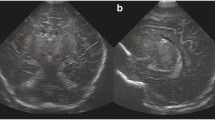Abstract
Background: Diagnosis of brain lesions after birth anoxia-ischemia is essential for appropriate management. Clinical evaluation is not sufficient. MRI has been proven to provide useful information. Objective: To compare abnormalities observed with MRI, including diffusion-weighted imaging (DWI), localised magnetic resonance spectroscopy (MRS) and chemical shift imaging (CSI) and correlate these findings with the clinical outcome. Materials and methods: Fourteen full-term neonates with birth asphyxia were studied. MRI, MRS and CSI were performed within the first 4 days of life. Results: Lesions observed with DWI were correlated with outcome, but the apparent diffusion coefficient (ADC) did improve diagnostic confidence. The mean value of Lac/Cr for the neonates with a favourable outcome was statically lower than for those who died (0.22 vs 1.04; P = 0.01). The same results were observed for the Lac/NAA ratio (0.21 vs 1.23; P = 0.01). Data obtained with localised MRS and CSI were correlated for the ratio N-acetyl-aspartate/choline, but not for the other metabolites. No correlation was found between the ADC values and the metabolite ratios. Conclusions: Combination of these techniques could be helpful in our understanding of the physiopathological events occurring in neonates with asphyxia.


Similar content being viewed by others
References
Thornberg E, Thiringer K, Odeback A, et al (1995) Birth asphyxia: incidence, clinical course and outcome in a Swedish population. Acta Paediatr 84:927–932
Wayenberg JL, Vermeylen D, Damis E (1998) Définition de l’asphyxie à la naissance et incidence des complications neurologiques et systémiques chez le nouveau-né à terme. Arch Pediatr 5:1065–1071
Gonzalez de Dios J, Moya M (1996) Perinatal asphyxia, hypoxic-ischemic encephalopathy and neurological sequelae in full-term newborns: an epidemiological study. Rev Neurol 24:812–819
Forbes KP, Pipe JG, Bird R (2000) Neonatal hypoxic-ischemic encephalopathy: detection with diffusion-weighted MR imaging. AJNR 21:1490–1496
Liu AY, Zimmerman RA, Haselgrove JC, et al (2001) Diffusion-weighted imaging in the evaluation of watershed hypoxic-ischemic brain injury in pediatric patients. Neuroradiology 43:918–926
Takeoka M, Soman TB, Yoshii A, et al (2002) Diffusion-weighted images in neonatal cerebral hypoxic-ischemic injury. Pediatr Neurol 26:274–281
Roelants-Van Rijn AM, Nikkels PG, Groenendaal F, et al (2001) Neonatal diffusion-weighted MR imaging: relation with histopathology or follow-up MR examination. Neuropediatrics 32:286–294
Kadri M, Shu S, Holshouser B, et al (2003) Proton magnetic resonance spectroscopy improves outcome prediction in perinatal CNS insults. J Perinatol 23:181–185
Zarifi MK, Astrakas LG, Poussaint TY, et al (2002) Prediction of adverse outcome with cerebral lactate level and apparent diffusion coefficient in infants with perinatal asphyxia. Radiology 225:859–870
Tzika AA, Vajapeyam S, Barnes PD (1997) Multivoxel proton MR spectroscopy and hemodynamic MR imaging of childhood brain tumors: preliminary observations. AJNR 18:203–218
Amiel-Tison C, Ellison P (1986) Birth asphyxia in the fullterm newborn: early assessment and outcome. Dev Med Child Neurol 28:671–682
Wolf RL, Zimmerman RA, Clancy R, et al (2001) Quantitative apparent diffusion coefficient measurements in term neonates for early detection of hypoxic-ischemic brain injury: initial experience. Radiology 218:825–833
Gire C, Nicaise C, Roussel M, et al (2000) Hypoxic-ischemic encephalopathy in the full-term newborn. Contribution of electroencephalography and MRI or computed tomography to its prognostic evaluation. A propos of 26 cases. Neurophysiol Clin 30:97–107
Pressler RM, Boylan GB, Morton M, et al (2001) Early serial EEG in hypoxic ischaemic encephalopathy. Clin Neurophysiol 112:31–37
Barkovich AJ, Hajnal BL, Vigneron D, et al (1998) Prediction of neuromotor outcome in perinatal asphyxia: evaluation of MR scoring systems. AJNR 19:143–149
Robertson NJ, Kuint J, Counsell TJ, et al (2000) Characterization of cerebral white matter damage in preterm infants using 1H and 31P magnetic resonance spectroscopy. J Cereb Blood Flow Metab 20:1446–1456
Majos C, Alonso J, Aguilera C, et al (2003) Proton magnetic resonance spectroscopy ((1) H MRS) of human brain tumours: assessment of differences between tumour types and its applicability in brain tumour categorization. Eur Radiol 13:582–591
Fan G, Wu Z, Chen L, et al (2003) Hypoxia-ischemic encephalopathy in full-term neonate: correlation proton MR spectroscopy with MR imaging. Eur J Radiol 45:91–98
Sarnat HB, Sarnat MS (1976) Neonatal encephalopathy. Following foetal distress. A clinical and electroencephalography study. Arch Neurol 33:696–705
Barkovich AJ, Baranski K, Vigneron D, et al (1999) Proton MR spectroscopy for the evaluation of brain injury in asphyxiated, term neonates. AJNR 20:1399–1405
Baik HM, Choe BY, Son BC, et al (2003) Feasibility of proton chemical shift imaging with a stereotactic headframe. Magn Reson Imaging 21:55–59
Harada M, Uno M, Hong F, et al (2002) Diffusion-weighted in vivo localized proton MR spectroscopy of human cerebral ischemia and tumor. NMR Biomed 15:69–74
Author information
Authors and Affiliations
Corresponding author
Rights and permissions
About this article
Cite this article
Brissaud, O., Chateil, JF., Bordessoules, M. et al. Chemical shift imaging and localised magnetic resonance spectroscopy in full-term asphyxiated neonates. Pediatr Radiol 35, 998–1005 (2005). https://doi.org/10.1007/s00247-005-1524-5
Received:
Revised:
Accepted:
Published:
Issue Date:
DOI: https://doi.org/10.1007/s00247-005-1524-5




